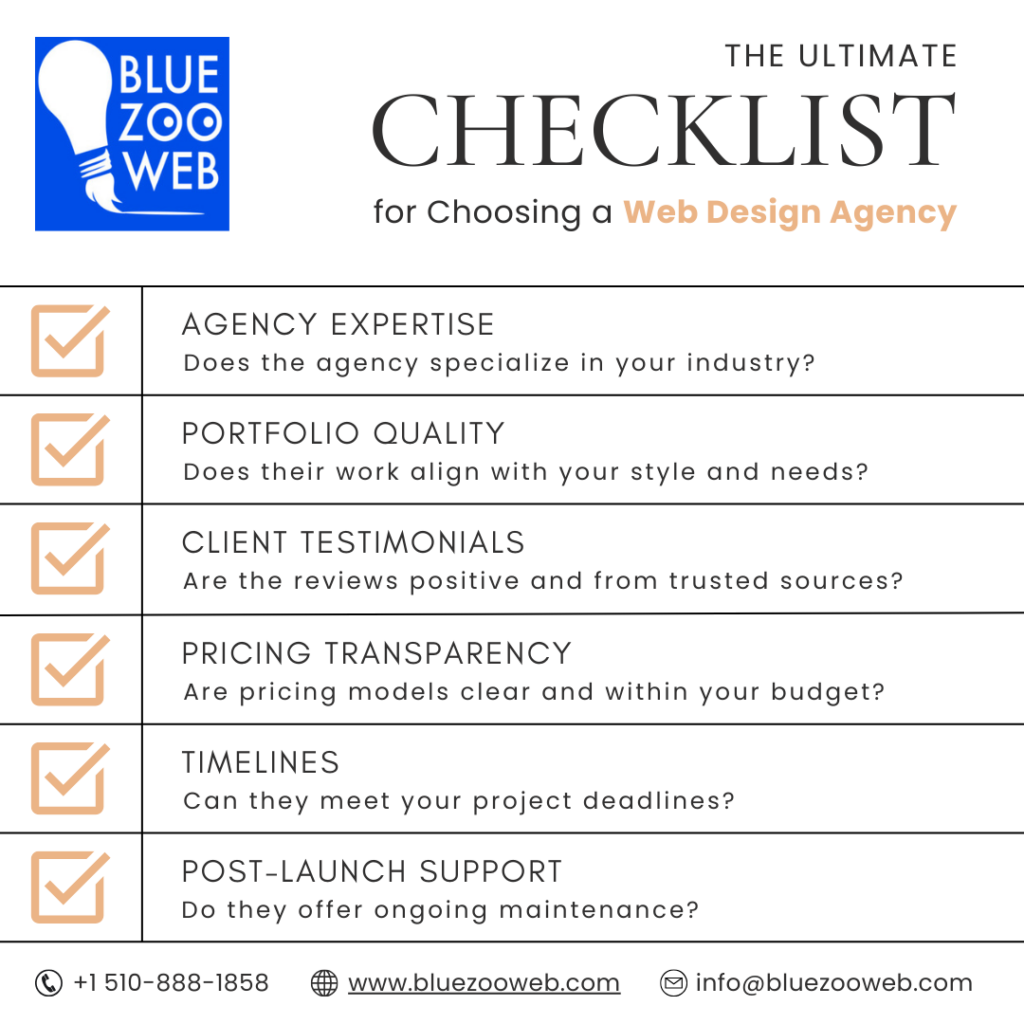1. Avoid Font Overload: Keep Visuals Clean
One of the biggest mistakes in graphic design is using too many fonts in one place. It might seem fun or creative to mix things up, but instead, it often makes your design look cluttered and confusing.
Imagine opening a website and seeing six different styles of text—bold, curly, fancy, thin, all in different sizes and colors. Your brain doesn’t know where to focus. It feels overwhelming. That’s exactly what happens when designs use more than two or three font styles in a single layout.
Why it matters:
- Fonts guide attention. When used right, fonts help people quickly understand what’s most important—like a headline, a product name, or a button.
- Too many fonts create distraction. Instead of guiding the reader, the design becomes noisy.
- Inconsistency breaks trust. A clean, simple font strategy shows professionalism and builds brand consistency.
What to do instead:
Stick to a maximum of two font families—one for headings and one for body text. Many successful brands use just one strong font and make it stand out with size, color, or weight (like bold or italic).
If you’re not sure which fonts go well together, many free tools online can help. The key is to keep it simple and intentional. One or two fonts are usually enough to create visual interest without causing distraction. Pair a bold font for headlines with a clean, easy-to-read style for body text. And always test how it looks on both desktop and mobile screens—what works well on a laptop may be hard to read on a phone.
2. Poor Color Choices and Contrast Issues: When Design Becomes Hard to Read
Color is one of the first things people notice in a design. But when the colors don’t work well together or don’t have enough contrast, your message can get lost—even if the layout is perfect.
Why bad color choices hurt your design:
- Hard to read = easy to ignore. If your text blends into the background, most people won’t even try to read it.
- Color sends a message. Bright red can feel urgent. Soft blue feels calm. But if colors clash or send mixed signals, the design loses meaning.
- Accessibility matters. Many users struggle to see low-contrast designs. Poor color contrast can make your design impossible for them to navigate.
According to the Web Content Accessibility Guidelines (WCAG), text and background colors should have a contrast ratio of at least 4.5:1 to be considered readable for most people. Tools like contrast checkers can help make sure your designs meet that standard.
How to get it right:
- Use a consistent color palette—stick to 2–4 main colors that work well together.
- Make sure text always stands out against the background.
- Test your designs on multiple screens and lighting conditions.
Choosing the right color combinations isn’t just about looks—it’s about making your message easy to read and your brand easy to remember. A well-balanced color scheme can help guide the eye, build trust, and make your site or design more inviting. Tools like contrast checkers and color palette generators can help you test and adjust your colors for better visibility and user experience.
3. Ignoring Mobile-Friendly Design: Why Your Graphics Must Work Everywhere
More than half of all web traffic now comes from phones and tablets. If your graphic design doesn’t look right on smaller screens, you risk losing that audience—fast.
What happens when designs aren’t mobile-ready:
- Text gets cut off or shrinks too small to read.
- Buttons or visuals overlap and look messy.
- Load times slow down, especially if your design isn’t optimized for mobile devices.
In today’s world, people switch between screens all day—laptops, phones, and tablets. So your graphics need to adjust smoothly across devices. This is called responsive design, and it makes sure everything looks just right no matter how someone is viewing it.
Smart practices for mobile-friendly graphic design:
- Use larger font sizes for easy reading on small screens.
- Avoid packing too much detail into one image.
- Test your graphics on multiple devices before publishing.
Even beautifully designed graphics can fail if they don’t fit the screen people are using. Making your designs mobile-friendly shows your audience that you care about their experience—not just how your brand looks.
4. Using Low-Quality Images or Graphics — Why Your Visuals Must Reflect Your Brand
Images are often the first thing people notice. Whether it’s on your website, a brochure, or a social media post — your graphics instantly shape how others see your brand. If your visuals are blurry, pixelated, or stretched, it sends the wrong message: your brand might not be professional or trustworthy.
What happens when image quality is poor:
- Visitors may leave your site quickly, thinking it’s outdated or not credible.
- Blurry visuals make your content harder to understand.
- Large, unoptimized images can slow down page load times — especially on phones.
In fact, a report by Adobe found that 38% of people stop engaging with websites if the content or layout doesn’t look good. And poor-quality images are often the reason why.
How to make your visuals work better:
- Always use high-resolution images that look clear on any screen.
- Make sure graphics are the right size — not stretched or squeezed.
- Compress images properly so your site stays fast.
If you’re working with a tight budget, free image libraries like Unsplash and Pexels offer high-quality visuals. But for brands that want to stand out, nothing beats custom visuals made by professionals. A skilled graphic design agency USA or experienced web graphic design company can craft images that look sharp, load fast, and match your brand perfectly.
5. Cluttered Layouts That Confuse Visitors — How to Create a Clear, Focused Design
Have you ever visited a website or seen a design that felt overwhelming? Too many buttons, images, text blocks, and bright colors fighting for your attention all at once? This is called a cluttered layout, and it’s a common mistake that businesses make when they try to communicate too much too quickly.
What happens when your design is too cluttered:
- The layout feels chaotic and confusing.
- Visitors get overwhelmed and leave your site before they can fully absorb your message.
- It becomes harder for users to find what they’re looking for, leading to frustration and potentially lost conversions.
Studies show that users form an opinion about your site in just 0.05 seconds. If your design feels disorganized, people are more likely to bounce quickly — and they might never even know what your business has to offer.
Why simplicity matters in design:
Great design is about creating a clear, easy-to-follow path. It’s not about filling up every inch of space with content or visuals. By using clean layouts, incorporating plenty of white space (empty space around elements), and focusing on the essentials, you make it easier for visitors to navigate your site and understand your message.
Think of your layout like a room. If there’s too much furniture crammed into the space, it’s hard to move around. But when everything is organized and placed thoughtfully, the room feels more open and inviting. The same principle applies to web design.
To avoid clutter, focus on:
- Clear structure: Organize your content in a way that’s easy for visitors to follow.
- Strategic use of white space: Don’t be afraid to leave some areas empty to help guide the visitor’s eye and reduce visual noise.
- Simplified navigation: Ensure buttons, links, and menus are easy to understand and access.
Many businesses turn to a graphic design company in California or a graphic design agency USA to help them create a clean, user-friendly layout. These experts know how to balance aesthetics with functionality, ensuring that the design serves not only to look good but also to enhance the user experience.
6. Forgetting to Maintain Consistent Branding — Why Consistency Matters in Design
Consistency is key when it comes to your brand’s visual identity. From your website to social media posts, and even your email newsletters — everything needs to align with your brand’s style, colors, fonts, and messaging. If your designs are all over the place, it confuses your audience and makes it harder for them to recognize and trust your brand.
What happens when branding isn’t consistent:
- Your brand looks unprofessional and disjointed.
- Customers might struggle to remember who you are and what you stand for.
- Visual elements may not work together, creating a disorganized, unappealing look.
For example, if your website uses one set of colors and fonts, but your social media uses a completely different style, your audience may get mixed messages about your brand.
How to ensure branding stays consistent:
- Create brand guidelines that include your logo, fonts, color palette, and image style.
- Stick to those guidelines across all your platforms.
- Make sure your visuals represent the tone and personality of your brand — whether it’s professional, fun, or friendly.
By keeping everything aligned, your audience will begin to recognize your brand, building trust and reinforcing the positive image you want to project.
7. Overusing Effects and Filters in Design — Why Simplicity is Key
In the world of graphic design, it’s easy to get carried away with all the fancy effects and filters available. Whether it’s shadows, gradients, or intricate textures, there’s a temptation to use every tool at your disposal. However, overusing these effects can lead to cluttered, distracting designs that overwhelm your audience.
What happens when you overuse effects and filters:
- Your design becomes visually chaotic, making it hard for users to focus on the main message.
- The design can appear unprofessional or amateurish.
- Make sure your visuals represent the tone and personality of your brand — whether it’s professional, fun, or friendly.
Why simplicity works better in design:
- A clean, minimalistic design ensures that the message is clear and easy to understand.
- It helps the audience focus on what matters, like your products or services, instead of getting distracted by unnecessary details.
- Simplicity often adds elegance and sophistication to your visuals.
How to strike the right balance:
- Use effects and filters sparingly to enhance your design, not overpower it.
- Focus on making your design easy to read and navigate, with clean lines and intuitive layouts.
- Consider the purpose of each design element and make sure it adds value to the overall aesthetic.
While effects and filters can be fun, remember that they should enhance your message, not detract from it. Keep your designs simple, elegant, and user-friendly to ensure the best possible experience for your audience.
8. Overlooking Accessibility Considerations – Why Inclusive Design Matters
Designing for everyone means making sure everyone can actually use and enjoy your content — including people with visual, hearing, cognitive, or motor impairments. Yet one of the most overlooked aspects in graphic design is accessibility.
What happens when you ignore accessibility:
- People with vision issues might not be able to read low-contrast text.
- Users who rely on screen readers can miss key content if images aren’t properly labeled.
- Someone with color blindness might not understand your color-coded messages.
- Navigation becomes difficult for users who rely on keyboards or other assistive tech.
If your designs don’t consider these users, you’re unintentionally turning away a large portion of your audience. In fact, according to the World Health Organization, over 1 billion people worldwide live with some form of disability — that’s a lot of potential customers who could be excluded if accessibility isn’t built in from the start.
Simple ways to make your design more accessible:
- Use strong contrast between text and background for better readability.
- Add alt text to images so screen readers can describe them.
- Avoid relying on color alone to communicate important information.
- Choose easy-to-read fonts and maintain consistent structure.
- Make sure clickable elements like buttons or links are large enough and easy to use.
Accessibility isn’t just a checklist item — it’s a key part of good design. It makes your content more usable, improves your SEO, and shows that your brand values inclusivity. Whether you’re working with a web graphic design company or building designs in-house, accessibility should be part of the process from the beginning.
Design that works for everyone is design that works better for everyone — more readable, more user-friendly, and more effective.
9. Neglecting to Test and Get Feedback — Why It’s Crucial to Refine Your Design
No matter how great your graphic design may look at first glance, it’s essential to remember that what works for you may not always work for your audience. Without proper testing and feedback, you risk missing out on potential improvements that could make your designs more effective, engaging, and user-friendly.
What happens when you skip testing and feedback:
- You might overlook areas where the design isn’t clear or intuitive for your audience.
- Elements like color contrast, readability, or navigation might not work well across different devices or user demographics.
- You may miss opportunities to improve conversions or user engagement.
Why testing and feedback matter:
- Testing allows you to catch issues early before they affect a wider audience. For instance, checking how your design looks on various screen sizes can prevent your design from
looking awkward on mobile devices.
- Gathering feedback from users or stakeholders helps identify areas of confusion or frustration, enabling you to refine the design to better meet their needs.
- Feedback and testing also help ensure your design resonates with your target audience and supports your business goals.
How to effectively test and gather feedback:
- Conduct A/B testing to see how different design elements perform with your audience.
- Gather input from real users through surveys, focus groups, or usability testing to understand how they interact with your design.
- Use analytics to see how well your design is performing. Are users engaging with the content? Are they leaving the page quickly? This data can help you make informed decisions.
Testing and feedback are invaluable tools in the design process. They allow you to make informed choices, leading to a final product that is not only visually appealing but also highly functional and user-centric.
10. Relying Too Heavily on Trends – When “Trendy” Hurts Your Brand
It’s easy to get caught up in what’s trending. Bold fonts, neon gradients, retro vibes — they’re all over social media and design showcases. But just because something looks cool right now doesn’t mean it’s the right choice for your brand.
What happens when design becomes too trend-focused:
- Your brand starts to look like everyone else.
- The design might go out of style quickly, making your materials feel outdated.
- It distracts from your core message and confuses your audience.
- You might miss the chance to build a lasting identity.
Design trends change fast — what’s hot today might be gone tomorrow. If your brand’s identity keeps shifting to chase what’s new, it becomes harder for people to recognize and trust you.
That doesn’t mean you should ignore trends altogether. Used wisely, they can add freshness and keep your design feeling modern. But the key is balance. Trends should support your brand — not replace it.
How to use design trends the smart way:
- Stick to your brand colors, fonts, and tone — and layer trends on top in small ways.
- Focus on trends that align with your brand’s personality and audience.
- Test how trend-based elements work across different channels (website, print, social).
- Ask if the trend adds value or just adds noise.
Timeless design is built on clarity, consistency, and connection — not just what’s popular. That’s why experienced design teams, whether from a graphic design agency USA or a graphic design company in California, often mix modern inspiration with tried-and-true principles that never go out of style.
11. Forgetting About the User Journey – Why Your Design Needs to Guide, Not Just Look Pretty
A website is more than just a collection of pages; it’s an experience. Every user who visits your site has a journey — from the first click to the final action, like making a purchase or signing up for a newsletter. If your design doesn’t consider how users move through your site, it can lead to frustration, confusion, or worse — abandonment.
What happens when the user journey is ignored:
- Visitors get lost, not sure where to go next.
- They don’t find what they need quickly and leave.
- Calls to action (CTAs) are hidden or unclear, leading to missed opportunities.
- A disjointed experience creates frustration, which lowers conversions.
The goal of any great design is to guide the user step-by-step toward the desired action, whether that’s buying a product, signing up for a service, or simply learning more about your brand. Your site should feel intuitive, like a clear path where visitors know exactly what to do next.
Best practices for mapping the user journey:
- Create clear CTAs: Make sure visitors know where to click or what to do next. Use action-oriented language like “Get Started” or “Shop Now.”
- Simplify navigation: Keep menus simple and logical, so users can find what they need quickly.
- Provide easy-to-follow paths: Whether through product categories, blog posts, or service pages, ensure visitors can easily navigate through your content.
- Focus on the first impression: The first few seconds matter most. Make sure your homepage delivers an immediate value proposition.
Remember, great design isn’t just about looking good; it’s about making sure the user experience is seamless and effective. By considering the user journey, you can create a website that not only looks professional but works with your visitors, helping them move through the content without confusion or frustration.
12. Neglecting SEO in Your Graphic Design – Why Visuals and SEO Must Work Together
While a beautiful design can captivate your audience, it’s not enough to simply rely on aesthetics. SEO (Search Engine Optimization) plays a crucial role in ensuring your website ranks well on search engines, and it’s essential to include SEO best practices in your graphic design. Neglecting this can lead to great visuals that are invisible to search engines and users alike.
What happens when SEO is ignored in design:
- Images and graphics aren’t optimized for search engines, making it harder for your content to be discovered.
- Slow loading times due to unoptimized images can negatively affect both SEO rankings and user experience.
- Lack of alt text and proper file naming can limit accessibility and reduce your site’s discoverability.
- Search engines can’t index images, videos, or other visual content without the proper SEO tagging.
Just because your website looks amazing doesn’t mean it’s optimized for search engines. Search engines, like Google, can’t “see” images the way humans do. Instead, they rely on text, alt attributes, metadata, and file names to understand what’s in an image and how it relates to the content.
How to integrate SEO with your graphic design:
- Optimize images for faster loading times: Compress files without losing quality to improve page speed, a critical factor for SEO.
- Use descriptive alt text for all images: Alt text helps search engines understand the content of your images and makes your site more accessible.
- Proper file names: Avoid generic names like “image1.jpg” — use descriptive names that reflect the content, such as “red-shoes-sale.jpg.”
- Responsive design and mobile optimization: Google prioritizes mobile-friendly sites in its rankings. Ensuring your graphics scale well on mobile devices is essential for SEO.
By combining SEO with your graphic design strategy, you ensure that your visuals contribute to both a great user experience and strong search engine visibility. SEO isn’t just for text — your images, videos, and overall design need to be optimized to help your site rank higher and attract more organic traffic.
13. Failing to Keep Your Design Updated – Why Regular Updates Matter
In the ever-evolving digital world, trends, technologies, and user preferences change quickly. This means that if your website’s design stays static and doesn’t get updated regularly, it can quickly feel outdated and out of touch with current expectations. An outdated design can impact user experience, brand perception, and even your website’s functionality.
What happens when your design isn’t updated:
- Users may think your brand is no longer active or reliable.
- An outdated design can lead to poor mobile performance, as old designs may not support newer devices or browser versions.
- Proper file names: Avoid generic names like “image1.jpg” — use descriptive names that reflect the content, such as “red-shoes-sale.jpg.”
- Your website may fall behind in terms of accessibility and security features.
- Outdated designs can make your competitors appear more modern and relevant, potentially driving customers away.
Why regular updates matter:
- Aligning with current trends and technology: Web design trends evolve quickly, from color schemes and typography to navigation styles and interactivity. Staying on top of these trends helps you keep your website fresh and appealing to your audience.
- Improving functionality and user experience: With each update, you can improve usability, performance, and the overall flow of your website. Regularly reviewing your design helps identify pain points and areas for improvement.
- Maintaining security and compliance: Outdated designs may lack necessary security features, putting your site at risk. Updating your design ensures you’re compliant with new security standards and regulations.
- Boosting brand trust: A modern, functional, and aesthetically pleasing website reflects well on your brand. It shows that you’re invested in your business and care about providing your users with the best experience.
How to keep your design updated:
- Regular design audits: Periodically review your website’s design, user experience, and performance. Check for outdated features or elements that may need refreshing.
- Adopt new technologies: As new web technologies and design tools emerge, consider integrating them into your website. This could mean adopting a new framework, optimizing for better performance, or improving mobile responsiveness.
- Customer feedback: Regularly ask for feedback from your users about their experience with your website. This input can help you understand what changes are needed to improve their experience.
- Stay updated with design trends: Follow design blogs, participate in design communities, and stay informed about the latest trends.
By keeping your design updated, you ensure your website stays competitive, functional, and aligned with the expectations of your audience. Regular updates also signal to your visitors that you are proactive and committed to delivering the best experience.
14. Ignoring Analytics and Performance Data: Why Tracking Matters
As a business, it’s important to understand how well your website and designs are performing. Ignoring analytics and performance data is like driving without a GPS — you might have a destination in mind, but without the right information, it’s easy to get lost or make wrong turns.
What happens when you ignore analytics and performance data:
- You may not know which aspects of your website are working well or which need improvement.
- It’s harder to understand your audience’s behavior, making it challenging to design for their needs.
- Without tracking, you risk missing out on optimization opportunities, potentially lowering your conversions and engagement.
- Your marketing campaigns may not be as effective because you lack the data needed to target the right audience.
Why tracking and data matter:
- Understand user behavior: Analytics help you track how users interact with your website, which pages they visit, how long they stay, and where they drop off. This insight helps you make informed decisions about design changes and optimize your user journey.
- Measure design effectiveness: Data tells you whether your design changes are having a positive or negative impact. For example, are your button placements driving conversions? Is the color scheme generating the right emotional response? Tracking performance allows you to see if your design choices are working.
- Continuous improvement: Analytics give you the power to test and tweak your website continuously. Through A/B testing and user feedback, you can make incremental improvements that lead to big results over time.
- Track business goals: Whether it’s increasing sales, generating leads, or growing your email list, tracking data lets you monitor how your design impacts your business goals. This data will help you refine your strategy and improve outcomes.
Best practices for leveraging analytics and data:
- Use Google Analytics: It’s a powerful tool for understanding website traffic, user demographics, behavior, and conversions. You can track things like page visits, bounce rates, and which pages have the highest engagement.
- Set up conversion tracking: This will help you measure the effectiveness of your call-to-action buttons, contact forms, or e-commerce sales funnels.
- A/B testing: Test different design variations to see which performs better. It’s a great way to learn what resonates most with your visitors.
- Heatmaps and user recordings: Tools like Hotjar or Crazy Egg allow you to see where users click, how far they scroll, and what actions they take on your website. This helps you understand how users interact with your design
Tracking your website’s performance not only helps you improve design but also allows you to make smarter business decisions. When you monitor analytics, you’ll have the insights needed to optimize your website continually and better meet your audience’s needs.
15. Missing the Emotional Connection
Why should design make people feel something? Good design doesn’t just look nice—it makes people feel. Whether it’s trust, excitement, curiosity, or calm, your graphic design should create a connection that goes beyond just visuals. When that emotional connection is missing, your design might be remembered for a second—but forgotten just as fast.
Why emotions matter in design:
- Emotions drive decisions. Studies show that people rely more on emotions than facts when making choices.
- Brands that connect emotionally with their audience build stronger loyalty and better long-term recognition.
- Design is storytelling. Colors, images, and layout choices all work together to tell a brand’s story—without needing words.
Common signs your design lacks emotional impact:
- It feels generic or like a copy of something else.
- It doesn’t reflect your brand’s personality or values.
- It doesn’t make people care enough to engage, click, or remember.
How to design with emotion in mind:
- Know your audience. What do they care about? What problems are they trying to solve? Build your visuals around that.
- Use color psychology to influence mood—blue for trust, red for urgency, green for growth, etc.
- Choose images that tell a human story, not just stock pictures of products or people staring at screens.
- Stay consistent with your message and tone across all platforms—this builds trust and emotional familiarity.
Even if you work with a leading graphic design agency USA or a top web graphic design company, your design will only succeed if it makes people feel something real. That emotional spark is what makes a design memorable—and what turns viewers into loyal customers.
Conclusion / Final Thoughts
Design Isn’t Just Art—It’s Communication That Works
Great graphic design isn’t about making things look pretty. It’s about making things clear, functional, and emotionally engaging. Every color, font, image, and layout choice should help your audience understand your message—and act on it. Whether you’re designing for a website, a social media post, or a business brochure, the goal remains the same: connect with your audience and guide them toward your brand.
Throughout this article, we’ve walked through some of the most common graphic design mistakes—from cluttered layouts to inconsistent branding, from ignoring accessibility to overusing trendy effects. These mistakes are surprisingly easy to make, but with the right awareness, they’re also easy to avoid.
If you want to build designs that reflect your brand, speak to your audience, and support your business goals, it’s worth investing in the right creative partner. A skilled graphic design company in California or a trusted graphic design agency in USA can help you bridge the gap between design that simply looks good—and design that actually works.
Need guidance on creating design that avoids these pitfalls and elevates your brand?
At BlueZoo Web, we bring clarity, creativity, and strategy together to craft visuals that truly connect. Let’s turn your ideas into powerful visuals that get results.





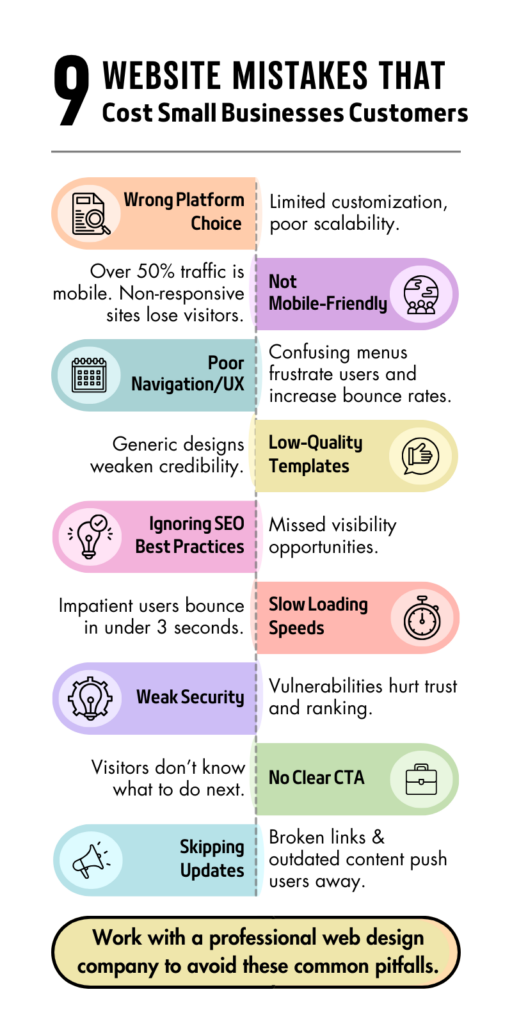 1. Selecting the Wrong Platform for Web Design
1. Selecting the Wrong Platform for Web Design 2. Disregarding Mobile Responsiveness in Web Design
2. Disregarding Mobile Responsiveness in Web Design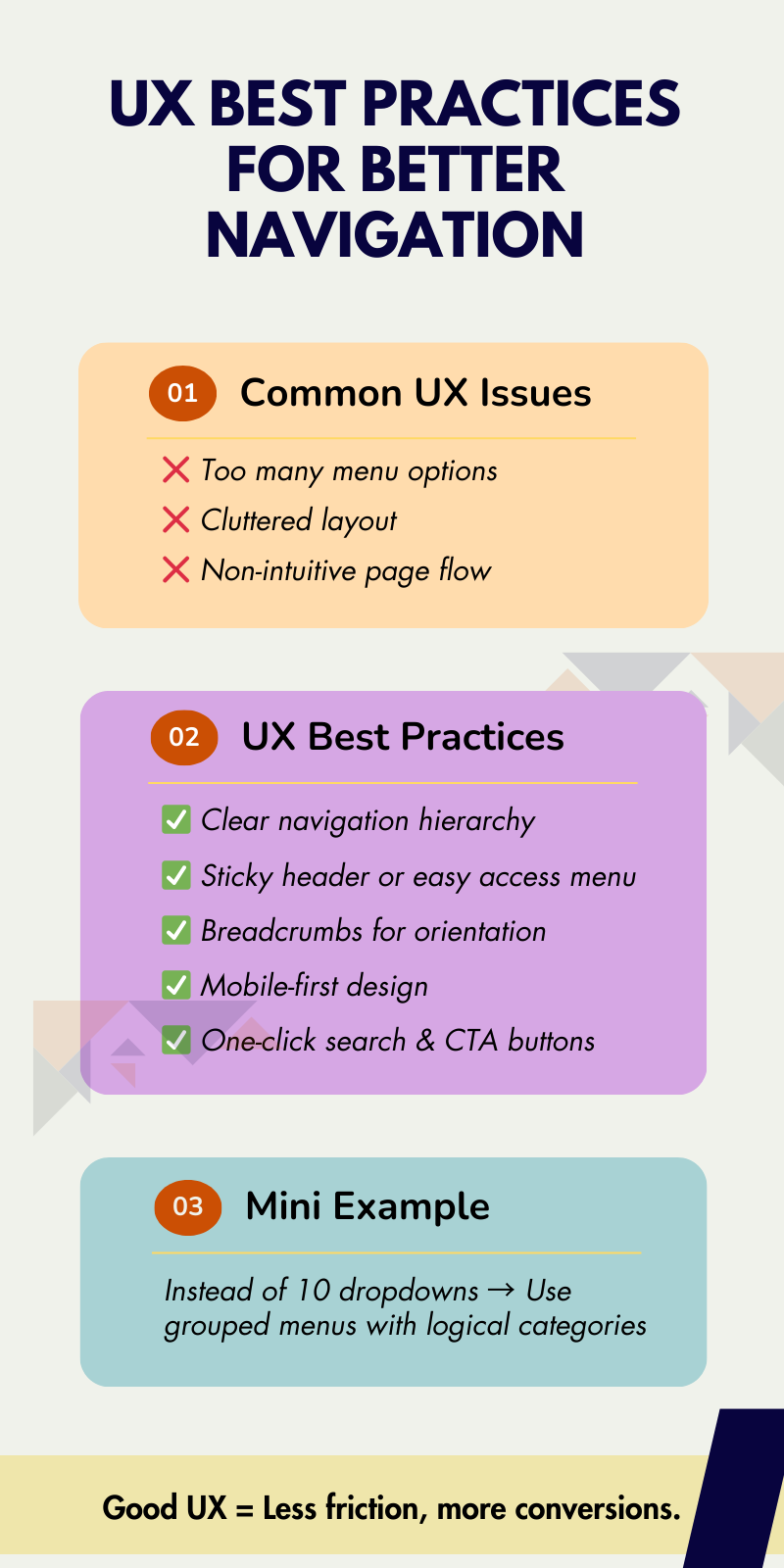 3. Poor Navigation and User Experience (UX) in Affordable Website for Small Business
3. Poor Navigation and User Experience (UX) in Affordable Website for Small Business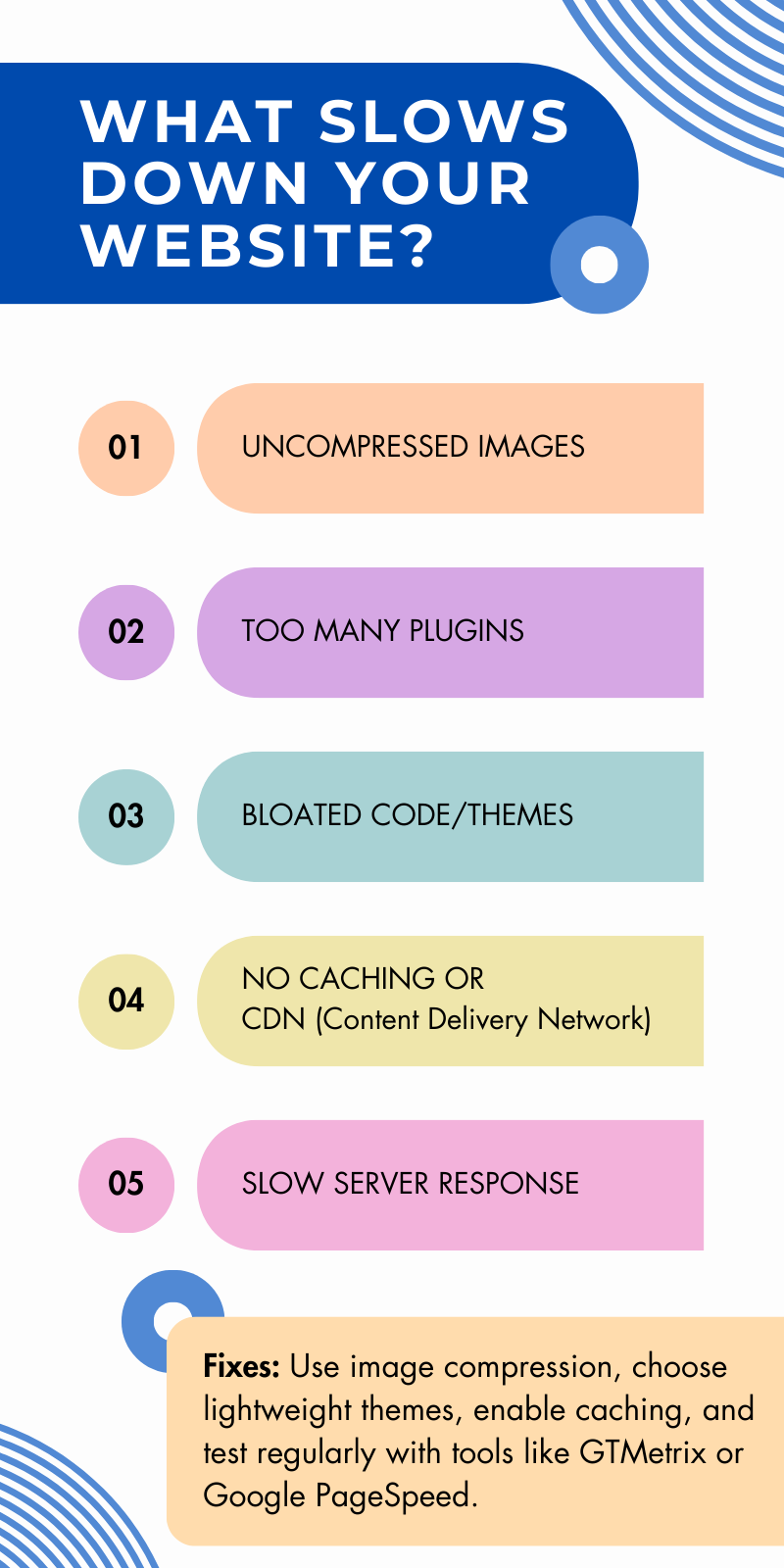 5. Disregarding SEO Best Practices
5. Disregarding SEO Best Practices 
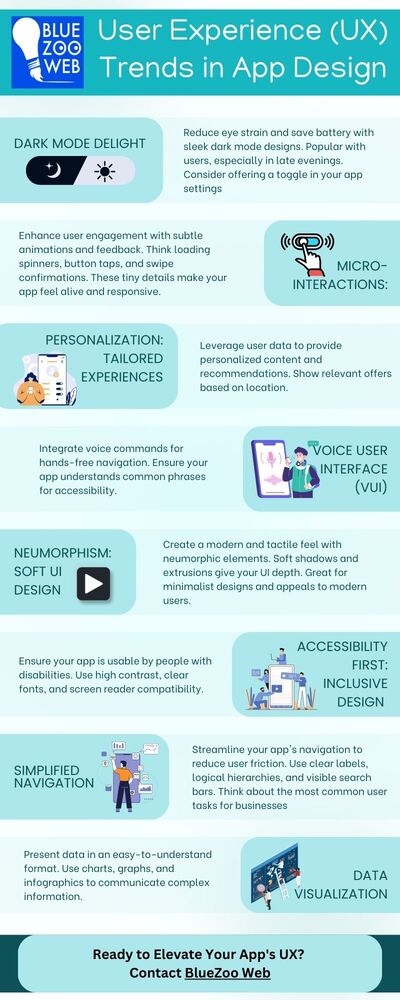 1. Artificial Intelligence (AI) and Machine Learning (ML)
1. Artificial Intelligence (AI) and Machine Learning (ML)

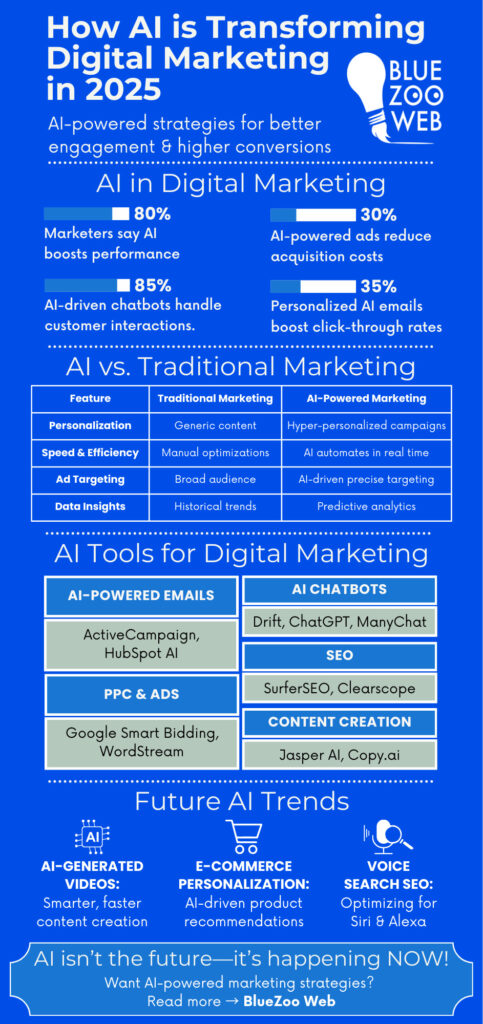 1. AI-Powered Personalization
1. AI-Powered Personalization
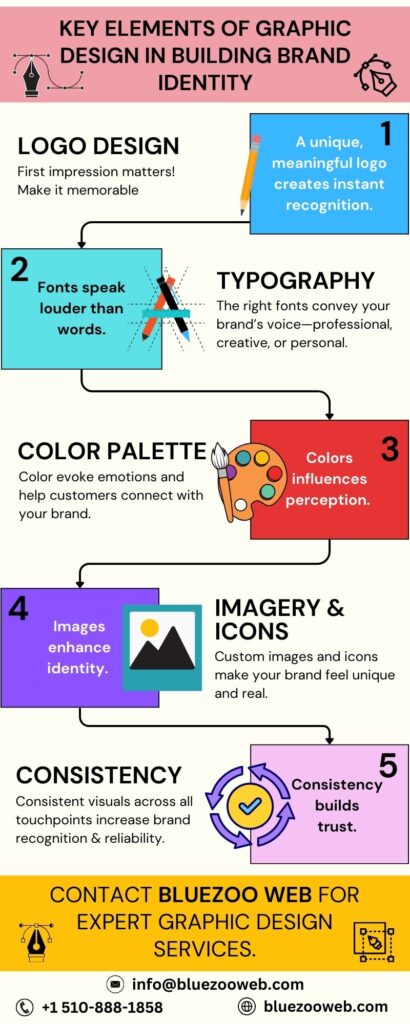 The Role of Graphic Design in Brand Identity
The Role of Graphic Design in Brand Identity

